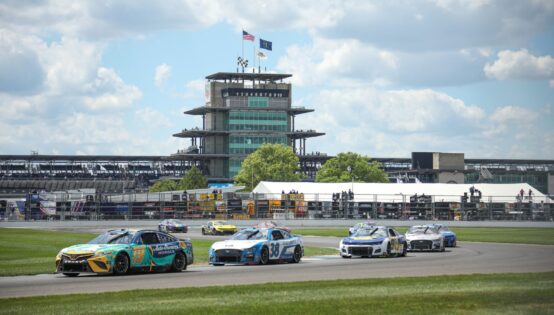“When we won that race [in 1994], it changed my life forever,” said Jeff Gordon, reflecting on his triumph at the inaugural Brickyard 400. Indianapolis Motor Speedway has always been one of the most iconic venues in the world of motorsports. Opened in 1909, the venue is known as the home of the Indianapolis 500 and features a rectangular 2.5-mile layout, which was paved with bricks in its early years. That’s why it earned the nickname, ‘The Brickyard’.
NASCAR hosted its first Cup Series race at Indianapolis back in 1994, with Jeff Gordon, only 23 years old at the time, taking home the triumph in front of a sold-out crowd. The Brickyard 400 has evolved into a crown-jewel fixture since then, with the likes of Dale Earnhardt, Jimmie Johnson, and Tony Stewart also winning at the racetrack. Here’s a breakdown of the origins and legacy of Indianapolis Motor Speedway.
The Original NASCAR Brickyard Race: A Legacy Built on Speed and Prestige
The Indianapolis Motor Speedway oval layout was built for drivers to push their cars to the limit, and it delivered in that regard. It delivered some iconic moments, such as Dale Earnhardt winning the 1995 race after finishing fifth the year before. It was the reigning champ’s third win of the season after triumphs at North Wilkesboro and Sonoma, as ‘The Intimidator’ finished above Rusty Wallace and Dale Jarrett in the 160-lap fixture.
However, Dale Jarrett managed to redeem himself a year later. Driving the No. 88 Ford, the Robert Yates Racing driver secured his first Brickyard win despite not leading until Lap 135 out of 160. Battling it out with fellow Ford driver Ernie Irvan, Jarrett passed for the lead with just seven laps remaining to become the first driver to win the Daytona 500 and the Brickyard 400 in the same year. That’s when he unknowingly started the tradition of taking crew chief Todd Parrott and other members of his crew to Indy’s iconic Yard of Bricks to kneel and kiss them. Now, even fans follow the tradition of ‘kissing the bricks’
The Indianapolis Motor Speedway has also played an important role in championship runs. Back in 2000, Bobby Labonte’s Brickyard 400 triumph played a vital role in his Cup Series championship. That win came in the heat of a fierce championship battle with Dale Earnhardt, where both of the drivers had not won a race since week 4 at Atlanta, when Earnhardt won and Labonte finished 2nd. The Brickyard 400 triumph gave Bobby the momentum he needed, as he went on to win two more races before Earnhardt won his next, securing his maiden Cup Series Championship.
Five years later, Indiana-native Tony Stewart gave fans one of the most emotional moments in Brickyard history by winning on his home track. ‘Smoke’ climbed the catch fence to celebrate with his crew and the crowd, and said afterwards, “If I died right now, my life’s complete.” With such a storied legacy along with championship narratives, why did NASCAR move away from Indianapolis’ traditional layout?
Why NASCAR Switched to the IMS Road Course in 2021
NASCAR made a bold move in 2021. It switched the Cup Series race from ovals to the infield road course. The reason was that the sanctioning body wanted to shake things up and deliver and more technical but exciting race for fans at an iconic venue. By that time, Indianapolis Motor Speedway’s road course had built quite a reputation, especially after hosting Formula 1 and IndyCar events.
The road course layout had sharp corners and flowing turns that cut through the infield before joining the oval sections of the track. It provided a new challenge for drivers, many of whom were used to competing on the traditional layout. The decision to transition from the 2.5-mile rectangular-shaped oval was to increase fan interest after the NASCAR Brickyard 400 went stale, and to create a tighter and more competitive race.
Initially, the move was well received by stock car racing enthusiasts, many of whom expressed curiosity and support for the road course format. However, fans and drivers had had enough soon after, with the majority of them asking for the traditional format to be returned. It’s what made the Brickyard 400 such a marquee event to begin with, and it was only fitting that it returned after a brief experiment.
The Return to the IMS Oval: Tradition, Excitement, and a Reboot
After three long years at the infield road course, NASCAR returned to the iconic Indianapolis Motor Speedway oval in 2024, and the reception was overwhelmingly positive. Kyle Larson secured the win at the 167-lap race after two overtime restarts, followed by Tyler Reddick and Ryan Blaney. The race marked a long-awaited return to tradition, bringing back that feeling of nostalgia and anticipation that was often associated with NASCAR’s Brickyard 400.
But the decision to return to the 2.5-mile oval wasn’t just rooted in nostalgia, as many felt returning to the traditional layout would lead to better quality racing. Denny Hamlin even said, “This car is made better for the oval, in my opinion.” Todd Gilliland, who tested at Indianapolis Motor Speedway last June, echoed the sentiment, saying, “Our cars have come a long way since the last time we were on the oval. The racing maybe wasn’t the best, but with this car it will be really good. I’m excited about it.”
While Indianapolis’ road course races some unique twists, the NASCAR community felt something was missing. The oval layout, with its long straights and tight corners, brought a different sort of excitement with the Next-Gen cars. For fans and drivers, watching stock cars dive into Turn 1 at nearly 200 mph is what made NASCAR’s Brickyard 400 so special. The return to ovals was a statement by NASCAR that some traditions are worth preserving.
The post Why Did NASCAR Change the Indianapolis Motor Speedway Oval Layout? Everything You Need to Know appeared first on EssentiallySports.
